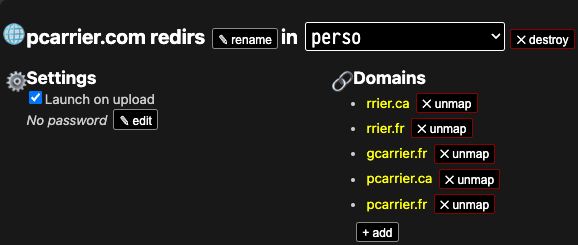There really is joy in using one's own software to solve one's own problems. I can't help but share my experience migrating my personal website to xmit.co, from a small VPS running nginx. I won't argue the benefits, having already done so in our first post (though I failed to point out what might be the most obvious to me, high availability through redundancy).
I have domain acquisition syndrome. For my name alone, over the years I've collected gcarrier.fr, pcarrier.ca,
pcarrier.fr, pcarrier.com, rrier.ca, rrier.fr.
The last two are merely a domain hack so I could be emailed at pc@rrier.ca & pc@rrier.fr.
pcarrier.com is the only web property left standing; everything else redirects to it,
with a quick hack so I could be found through @pc@rrier.ca & @pc@rrier.fr on the fediverse.
I already had an organization #19: perso, so I went straight to DNS, where I created the following records for all domains:
@ CNAME 19.xmit.co.
* CNAME 19.xmit.co.
@ TXT "xmit=19"
Then I launched my >1GB web directory with xmit pcarrier.com. That crashed halfway through the upload.
Implemented chunked uploads in the xmit CLI, released it, and finally relaunched with caching rules in xmit.toml:
[[headers]]
name = "Cache-Control"
value = "public, max-age=31536000"
on = "/fonts/.*"
For all the other domains, I launched a separate site with xmit rrier.ca from a directory with a lone xmit.toml:
[[headers]]
on = "^/.well-known/webfinger$"
name = "access-control-allow-origin"
value = "*"
[[redirects]]
from = "^/.well-known/webfinger$"
to = "https://mastodon.social/.well-known/webfinger?resource=acct%3Apcarrier%40mastodon.social"
[[redirects]]
from = "^/(.*)"
to = "https://pcarrier.com/$1"
permanent = true
After that, I headed to the xmit admin, clicked on the newly created site,
renamed it to pcarrier.com redirs, and added all the other domains on it:

That's all. I thought this worth sharing, though looking back this migration didn't amount to much. Happy to be building a rather boring piece of infrastructure.